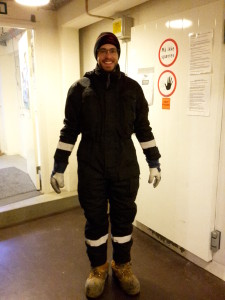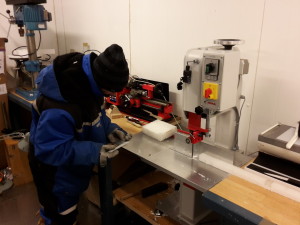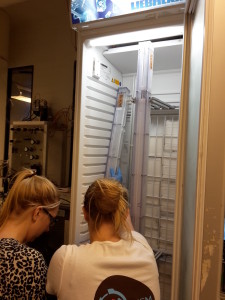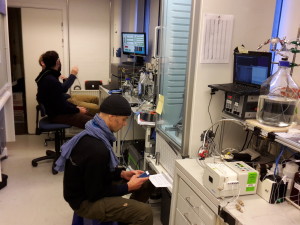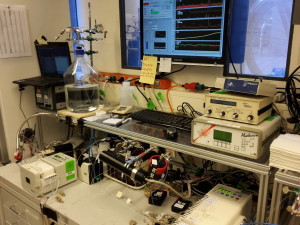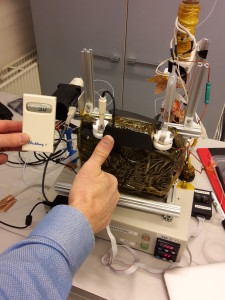The CFA melting campaign of the Renland ice core started mid-October at the Centre for Ice and Climate (CIC) in Copenhagen. Paul H. and Andreas from Bergen visited the lab early in the campaign and saw first-hand how an ice core is prepared and analyzed. Below is their explanation of the continuous flow analysis ice core lab.
The people at the CFA work in two shifts from 8-14 and from 14-until closing time. During a normal day approximately 16m of ice is being melted. The first part of the work begins in the “warm” freezer at -15°C. The cores are stored in an even colder freezer. So for this work you better pack yourself better than Paul did on his first day.
The ice cores are stored in 55cm long pieces; ideally if there are no breaks in between. To get a square-shaped core that fits into the melting frame, part of the core is cut again. Paul V. is showing the newcomer how it is done.
After that the filled melting frames are put in a freezer in the lab where they are melted via the so-called melt head.
The melt rate is governed by the temperature of the melt head. You can nicely see the air bubbles within the ice.
Then the melted ice is separated into a lots of little streams, both gaseous and liquid. The “gas people” measure stable water isotopes (delta_18O, delta_17O, delta_D) as temperature proxies and methane employing laser mass-spectrometry. The “liquid people” measure the sum of all dust, calcium, iron, conductivity, pH, NH4+, sodium, and black carbon, either using direct absorption or fluorescence. All these measurements are done from the continuous sample stream.
So let’s take a quick look at the lab. Paul watching the ice core has plenty of time to check emails.
The main screen of the liquid part measurements.
Finally the first part of the black carbon detector is Ross-approved.
Besides all the science, Copenhagen also offers nice sunsets, fantastic cycling, and a great bakery across from the apartment. We limited ourselves to one kanelsnulle per day.
We started to get an appreciation for the astounding amount of work and attention that goes into producing each time series from an ice core. Many thanks to our hosts in Copenhagen for spending the time teaching and talking with us.
